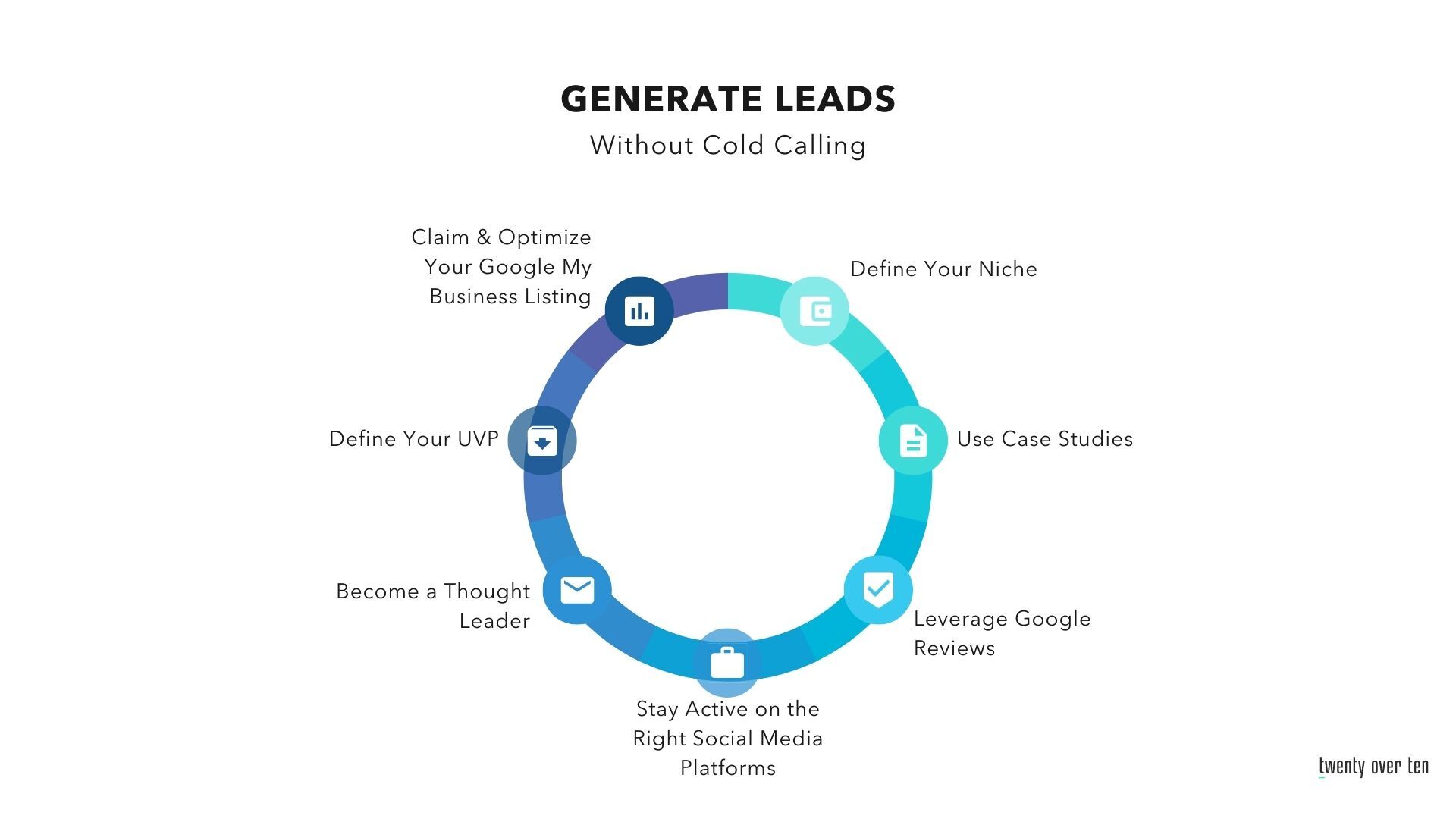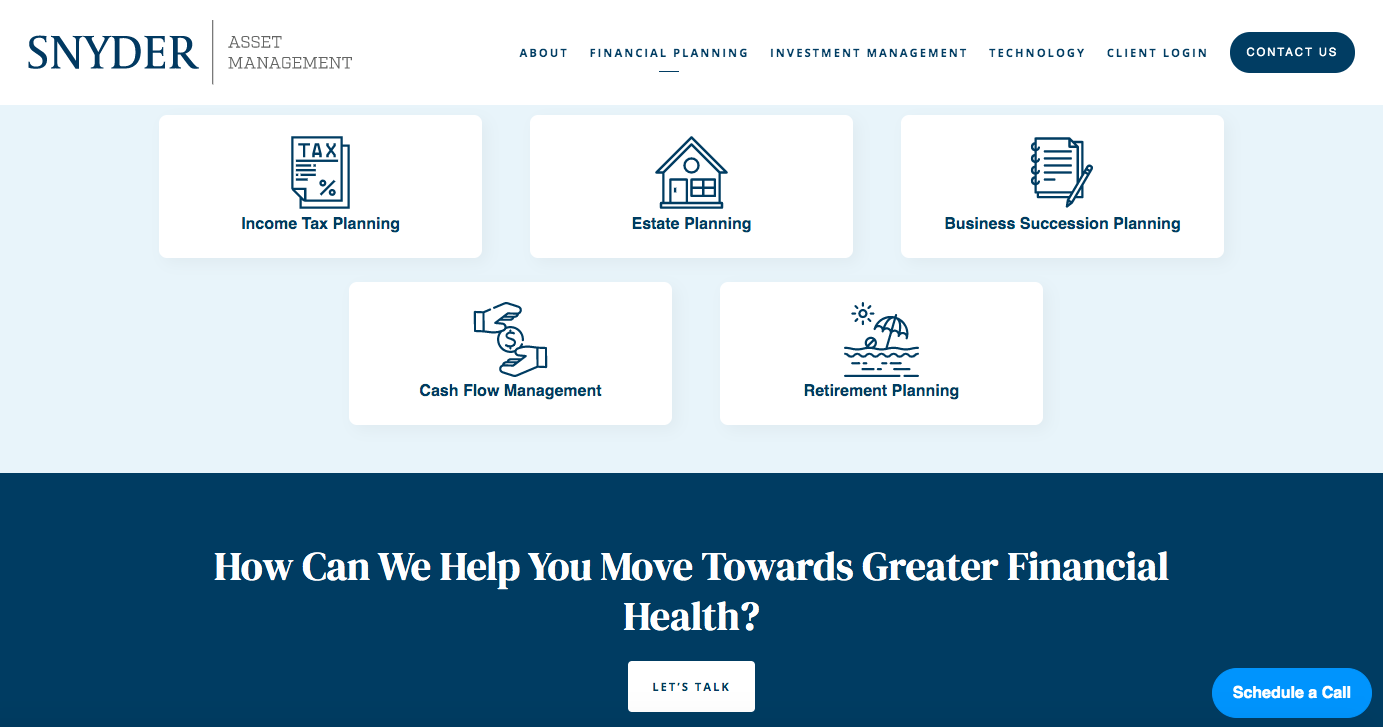The days of cold calling and outbound marketing techniques are coming to a close as inbound marketing has become the way of the future. When it comes to driving more leads to your advisor website, however, how do you do this? And how do you make sure that they are qualified leads that have the potential to become clients?
7 Ways to Generate Leads

Define Your Niche
First things first, figure out who your audience is because once you do that, you can figure out how to cater your content to better serve them. Financial planning is a very broad industry, so if you can narrow your audience down to a certain field and focus on a specific niche that is underserved, you can really establish yourself as an expert in that field. So, rather than focusing on general financial planning, you could narrow your niche down to pre-retirees and retirees, women, medical professionals, whatever it may be. If you can really cater to them, then you can put all your efforts towards being the strongest financial advisor in that particular field. Once you have defined your niche, how can you better serve your audience?
1. GENERATE STRONG CONTENT
A consistent blogging strategy is crucial to driving traffic to your site but if you cater to a particular niche, make sure the content you are putting out will help them on their financial journey.
2. USE THE CORRECT KEYWORDS
In order to attract the right type of audience, make sure you are using the type of keywords that your audience would be searching for.
3. USE EFFECTIVE CALLS-TO-ACTION
If a prospect is interested in your website, then work on converting your leads with a quality call-to-action that will entice them to take the next step down the sales funnel. you have a limited amount of time to engage visitors. Make sure you are giving that clear, direct instruction in the most efficient way. You have 7 seconds to make a strong first impression, so make sure you are engaging with them and then giving them clear, direct instructions on your call-to-action.

Twenty Over Ten client Snyder Asset Management includes a straightforward call-to-action that simply says, “Let’s Talk” after the question, “How Can We Help You Move Towards Greater Financial Health?” This then directs prospects to a Calendly link where they can easily schedule a meeting with Philip Snyder, CFA.
Define Your Unique Value Proposition
When it comes to defining your unique value proposition, how do you differentiate yourself from other firms? As we mentioned in the above point, the financial industry is incredibly saturated and if you can’t define what makes your firm different from the others, then it will be harder to sell your products. Here are 4 ways that you can define your UVP.
- See what your competitors are doing to differentiate themselves and get an idea of what your framework can look like.
- Determine your niche and who you want to serve
- Identify and outline the benefits that your firm can offer
- Write down your USP in just one to two sentences
This video can provide some extra insight on how to develop your UVP as a financial advisor.
Become a Thought-Leader
When you become a thought-leader in the industry, you are showing that you are a go-to expert and prospects can come to your website and firm to get the assistance and services that they need. So, how do you position yourself as a thought-leader in the financial industry?
1. PUBLISH INFORMATIVE AND EDUCATIONAL BLOG POSTS
Make sure these blogs are tailored to your niche audience and that you are posting them consistently. If you are trying to attract a certain audience, then creating content that will cater to them is key. Consistently posting is also crucial, as this boosts your SEO rankings, so search engines can better crawl your page plus your readers will notice a schedule for when you post content, making them more likely to consistently visit your site. If you are having a hard time consistently creating strong content, then Content Assist and Lead Pilot can help with this.
At Twenty Over Ten, we created Content Assist to assist financial advisors in creating blog posts specific to their audience and firm. Users are able to choose blog posts by category, load them into their website, and then edit and further optimize the content for search engines.

Lead Pilot is the industry’s first-ever AI-powered all-in-one solution for content creation and distribution. By using this tool, advisors are able to launch robust content campaigns from a streamlined, easy-to-use dashboard. Team members can collaborate and share content pieces, upload original content, and customize content from the media library. It not only includes blogs but also video and infographic content. Once it is added, the content can be easily scheduled to be sent out via email or social media with branded landing pages.
2. WORK WITH REPORTERS AND PUBLICATIONS
If you can get your articles into publications, then this is a great way to show that you are a thought-leader in the industry. If you are featured in a reputable source, then include that on your website, so that you can show your visitors that you are trustworthy and provide strong services. Some other ways to “get legs” out of getting a press hit are to:
- Share it on social media and make sure you are tagging the reporter or publication
- Include it in a blog
- Repurpose it in a newsletter or email campaign where you can share other information
3. INCLUDE AN FAQ PAGE ON YOUR WEBSITE
Including a Frequently Asked Questions page is a great way to cut down on initial calls or emails, as you may be able to answer questions of your prospects upfront. When you include an FAQ page, there are a few things that they can provide to your site.
- It serves as a built-in customer service by answering questions quickly.
- It fosters a positive user experience.
- It can boost your SEO, especially if you are using voice search.
When you are creating a strong FAQ page, you should “make it your own” and answer it in your own words, while keeping keywords in mind when providing your answers, in order to optimize for SEO. You should keep your page short and sweet, while also answering the questions thoroughly.
Twenty Over Ten client Dream Financial Planning does a great job with their FAQ page, answering their more frequently asked questions succinctly. Many times, what a potential client needs is to be directed to another part of your website, and being intentional about the questions you include, as well as how you answer them, is a huge part of improving the site navigation of your website.
4. CREATE A FREEMIUM
Who doesn’t like getting free stuff? If you create a “Freemium” than it’s a great way to capture leads and offer something useful to your audience. What is going to keep your visitors continuously coming back? Blogs that answer their question and provide them with actionable information that they can take away and apply to their own financial life.
In addition to creating useful information in your blogs, you offer them downloadable guides, such as eBooks, White Pages or anything else useful that can help them in their financial journey. Something to remember when including a “Freemium” is to include a call-to-action of sorts. If you want your readers to download a whitepaper or an eBook, then describe what it is about, then tell them to “Download the Whitepaper” in a button below the description. It encourages them to take the next step.
Twenty Over Ten client, Ascension College Planning offers a downloadable guide to provide families with useful information to help them plan for college.
Leverage Google Reviews
There are many regulations within the financial industry, so when it comes to online reviews, there are many questions that come up as far as what is allowed. When utilized correctly, Google Reviews are a great way to boost your firm’s SEO. Most of your prospects will check out your reviews before working with your firm, so it’s important that your firm has strong reviews. On this same page, it shows trust and authority in your firm.
Use Case Studies
Case studies are a great way to show your prospects what advisors can do for their prospects by providing examples of a particular situation. If you take a deep dive into one specific case, then you can paint a clear picture of your services, which allows clients and prospects to take a more in-depth look at what they can expect when they work with you. When creating case studies, dedicate a page solely for case studies, and ideally, you want potential clients to be drawn to them and encourage them to read them when they visit your website. Make sure you display them prominently so that they are easy to find.
Twenty Over Ten client Retirement Matters displays their case studies and have even dedicated an entire section to just that. They provide three different studies for unique situations, and those include:
- Pre-Retirement
- Retirement
- Retired
Each situation is tailored for certain people, but they encompass fairly broad scenarios, making it easy for prospects to choose one that is the most like their situation, so they can begin to plan with advice from the above case studies.
Claim and Optimize Your Google My Business Listing
If you want to boost your local search strategy, then claiming and optimizing your Google My Business listing is crucial. There are 7 ways to claim your listing and optimize your listing, and they are:
- Start by claiming your GMB listing
- Include categories to increase the chances your firm will show up
- Include your business description
- Include photos to boost rankings
- Make your listing local
- Get reviews
- Set up your service areas
Find out more about setting up your Google My Business listing in the article below.
Stay Active on the Right Social Media Platforms
Make sure you are staying active on the right social media platforms, and remember that simply having a presence on social media isn’t enough you have to differentiate yourself in today’s digital world. People seek social proof, so make sure you are getting creative with the content that you share on social. We say the right social media platforms because it is important to realize that you don’t need to be everywhere, so be aware of what platforms your target audience spends most of their time, and focus your efforts on that platform.
Like many other things, it’s about quality, not quantity, so it’s better to focus on platforms where your niche spends the most time. Maybe you cater to millennials or maybe you focus on retirees, so find out where they are spending most of their time online and focus on that platform. 90.4% of Millennials are active on social media and to successfully market to Millennials on social media, it’s best to incorporate eye-catching graphics and imagery. Share third-party articles and content that would be of interest to show that you are like-minded. Additionally, 75% of Millennials watch video content daily, so including video on social media is a great way to connect with them.
If you work with retirees, then Facebook is a great place to post your content. 64% of people aged 50-64 have at least one social media profile and Facebook is the most popular platform for baby boomers. This niche places emphasis on in-depth news pieces and analysis with an abundance of concrete information/. When sharing on social media, cater your content to meet their values.
If you offer planning for business owners, professionals and entrepreneurs, then LinkedIn is your “go-to” platform. There are over 630 million professionals on LinkedIn and a lot of them are you know upper-level professionals, so make sure you are connecting online with prospects, providing engaging content and interacting with them, as well.
Final Thoughts
The financial industry is rapidly changing, and that goes for how advisors get clients, as well. Inbound marketing is much more efficient than cold-calling, and while it’s a process with many moving pieces, it works very well when it comes to lead generation.
Related: Is Spending Time On Social Media Worth It for Financial Advisors Who Have Little to No Followers?






